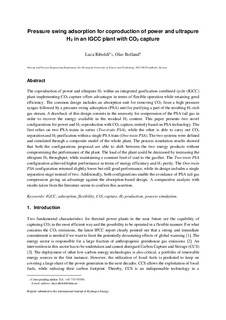| dc.contributor.author | Riboldi, Luca | |
| dc.contributor.author | Bolland, Olav | |
| dc.date.accessioned | 2017-10-31T13:47:49Z | |
| dc.date.available | 2017-10-31T13:47:49Z | |
| dc.date.created | 2016-05-11T15:18:43Z | |
| dc.date.issued | 2016 | |
| dc.identifier.citation | International journal of hydrogen energy. 2016, 41 (25), 10646-10660. | nb_NO |
| dc.identifier.issn | 0360-3199 | |
| dc.identifier.uri | http://hdl.handle.net/11250/2463258 | |
| dc.description.abstract | The coproduction of power and ultrapure H2 within an Integrated Gasification Combined Cycle (IGCC) plant implementing CO2 capture offers advantages in terms of flexible operation while retaining good efficiency. The common design includes an absorption unit for removing CO2 from a high pressure syngas followed by a Pressure Swing Adsorption (PSA) unit for purifying a part of the resulting H2-rich gas stream. A drawback of this design consists in the necessity for compression of the PSA tail gas in order to recover the energy available in the residual H2 content. This paper presents two novel configurations for power and H2 coproduction with CO2 capture, entirely based on PSA technology. The first relies on two PSA trains in series (Two-train PSA), while the other is able to carry out CO2 separation and H2 purification within a single PSA train (One-train PSA). The two systems were defined and simulated through a composite model of the whole plant. The process simulation results showed that both the configurations proposed are able to shift between the two energy products without compromising the performance of the plant. The load of the plant could be decreased by increasing the ultrapure H2 throughput, while maintaining a constant feed of coal to the gasifier. The Two-train PSA configuration achieved higher performance in terms of energy efficiency and H2 purity. The One-train PSA configuration returned slightly lower but still good performance, while its design includes a single separation stage instead of two. Additionally, both configurations enable the avoidance of PSA tail gas compression giving an advantage against the absorption-based design. A comparative analysis with results taken from the literature seems to confirm this assertion. | nb_NO |
| dc.language.iso | eng | nb_NO |
| dc.publisher | Elsevier | nb_NO |
| dc.title | Pressure swing adsorption for coproduction of power and ultrapure H2 in an IGCC plant with CO2 capture | nb_NO |
| dc.type | Journal article | nb_NO |
| dc.description.version | submittedVersion | nb_NO |
| dc.source.pagenumber | 10646-10660 | nb_NO |
| dc.source.volume | 41 | nb_NO |
| dc.source.journal | International journal of hydrogen energy | nb_NO |
| dc.source.issue | 25 | nb_NO |
| dc.identifier.doi | 10.1016/j.ijhydene.2016.04.089 | |
| dc.identifier.cristin | 1355108 | |
| dc.description.localcode | This is a submitted manuscript of an article published by Elsevier Ltd in International Journal of Hydrogen Energy, 6 May 2016 | nb_NO |
| cristin.unitcode | 194,64,25,0 | |
| cristin.unitname | Institutt for energi- og prosessteknikk | |
| cristin.ispublished | true | |
| cristin.fulltext | preprint | |
| cristin.qualitycode | 2 | |
